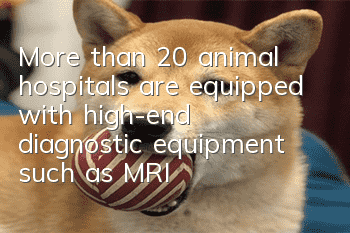More than 20 animal hospitals are equipped with high-end diagnostic equipment such as MRI or CT. Is it really necessary?

When taking pets to the hospital for medical examination, terms such as "CT", "MRI", "X-ray" and "B-ultrasound" are no strangers to pet owners. Currently, they are available in Beijing, Shanghai, Guangzhou and some provincial capital cities across the country. More than 20 pet hospitals are equipped with high-end diagnostic equipment such as MRI and CT. Depending on the condition and the complexity of the scanned area, the fee is usually between RMB 3,000-6,000 in different regions.
These similar-looking medical imaging equipment have huge price differences, often leaving owners confused. Why do we use "CT" sometimes and "MRI" sometimes? Is it because the condition is getting worse? In fact, they work on different principles and have their own division of labor. How to perform correct and appropriate inspections without wasting inspection fees is a topic of concern to pet owners.
Different principles and different advantages:
It is understood that CT (Computed Tomography) means X-ray computed tomography, which uses X-ray beams to perform tomography on a certain part of the body to obtain a cross-sectional or three-dimensional image of the examined part of the body. CT can provide complete three-dimensional information of the examined part of the body, clearly visualize organs and structures, and clearly display lesions.
X-rays are highly penetrating rays that can penetrate the body. X-rays are used to inspect the interior of the body for perspective or photography. The principle is to utilize the penetrating effect of X-rays. When penetrating the body, it is absorbed and weakened by calcium-containing components (bones), water (blood, etc.), soft tissues (muscles), etc., so it can show the basic shape of the area being inspected.
Unlike CT and X-ray, B-ultrasound examination uses the principle of ultrasound to produce echo. Ultrasound can propagate in a certain direction and can penetrate objects. If it encounters an obstacle, it will produce an echo. People use instruments to collect this echo and display it on the screen, which can be used to understand the internal structure of the object and assist in diagnosis. B-ultrasound is two-dimensional ultrasound information, which forms a flat figure and reflects the structure of the body.
With the emergence of color-Doppler ultrasound technology, color ultrasound (color B-ultrasound) appeared, that is, color Doppler was added to the black-and-white B-ultrasound. Color ultrasound also provided rich information on hemodynamics. In fact, The application has received widespread attention and welcome, and color ultrasound is often used clinically.
MR, MRI (nuclear magnetic resonance imaging), that is, magnetic resonance. MR is a biomagnetic spin imaging technology that uses the characteristics of the spin motion of atomic nuclei to generate radiofrequency pulses in an external magnetic field.After stimulation, a signal is generated, detected by a detector, input into a computer, and converted into an image.
- Can epilepsy in dogs be transmitted to people?
- Is it okay if the dog eats a little butter?
- Why do dogs feel like they don’t have enough to eat every day?
- Why does the Irish Red and White Setter have a dry nose?
- What should a female dog feed after giving birth?
- My dog’s period is gone and it’s still swollen down there
- How to train a Border Collie to fly a Frisbee
- My dog's leg fell and he was lame. How long did it take to heal?
- What to do if your dog has diarrhea continuously
- How to know a dog’s IQ? To understand the IQ of dogs, look here!



